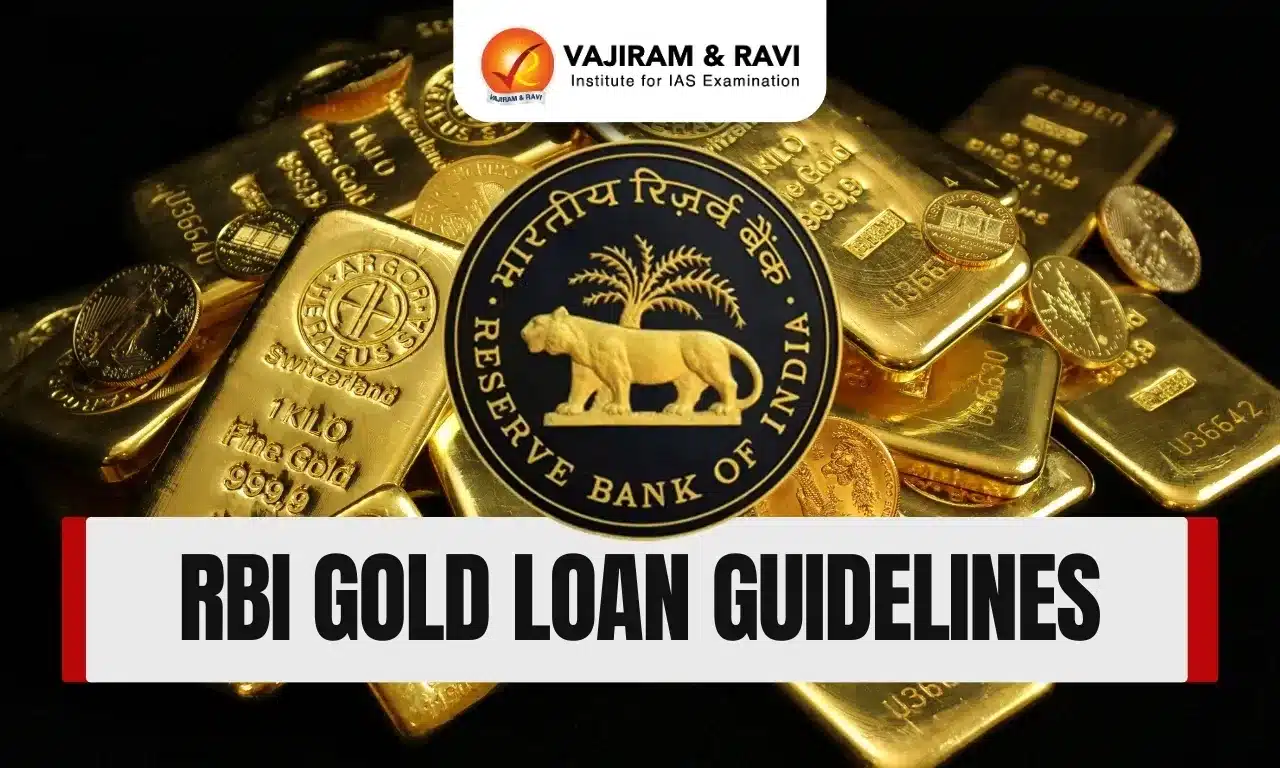What’s in Today’s Article?
- RBI Gold Loan Guidelines Latest News
- Surge in Gold Loan NPAs
- RBI Flags Irregular Practices in Gold Loans
- Draft Guidelines Released
- The Attractiveness of Gold Loans
- RBI Gold Loan Guidelines FAQs
RBI Gold Loan Guidelines Latest News
- The Reserve Bank of India (RBI) is introducing a framework for gold loans amid a sharp rise in gold loan outstanding and non-performing assets (NPAs).
- The surge in gold prices has led to increased gold loan disbursals, with NPAs rising by 28.58% and loan outstanding by 27.26% over the past year.
- The new framework aims to regulate the gold loan segment and mitigate potential risks.
Surge in Gold Loan NPAs
- Gold loan NPAs rose sharply by over ₹1,500 crore to ₹6,824 crore as of December 2024, compared to ₹5,307 crore a year earlier.
Break-Up of NPAs
- Commercial banks reported gold loan NPAs of ₹2,040 crore, up from ₹1,404 crore in December 2023.
- NBFCs reported NPAs of ₹4,784 crore, compared to ₹3,904 crore last year.
Gold Loan Outstanding Growth
- Total gold loan outstanding of banks and NBFCs stood at ₹11,11,398 crore in December 2024, rising from ₹8,73,701 crore a year ago.
Banks’ Share
- Commercial banks held the majority share with ₹9,23,636 crore in gold loan outstanding.
RBI Flags Irregular Practices in Gold Loans
- A review by the RBI revealed several deficiencies in gold loan practices, including:
- Use of third parties for sourcing and appraisal without proper oversight
- Valuation of gold in the absence of the customer
- Inadequate due diligence and end-use monitoring
- Lack of transparency in gold auctions after defaults
- Weak monitoring of Loan-to-Value (LTV) ratio
- Incorrect application of risk weights
RBI Directives to Lenders
- The RBI instructed banks and NBFCs to review their gold loan policies and processes, identify gaps, and take corrective measures within a set timeframe.
- It also emphasized strict monitoring of the gold loan portfolio and greater control over outsourced activities and third-party service providers.
Curbing Evergreening of Loans
- Previously, borrowers could repledge jewellery by just paying interest, enabling indefinite loan extensions.
- Post RBI intervention in September 2023, repledging now requires full repayment of principal and interest, making the process costlier and limiting loan evergreening.
Draft Guidelines Released
- On April 9, the RBI issued draft comprehensive guidelines for gold loans.
Prohibited Collateral
- Lenders are barred from granting advances against:
- Primary gold/silver
- Financial assets backed by primary gold/silver (e.g., ETFs, mutual fund units)
Loan-to-Value (LTV) Cap
- For consumption gold loans, the LTV ratio must not exceed 75% of the gold’s value.
Restrictions on Collateral Use
- Gold used as collateral for income-generating loans cannot be used simultaneously for consumption loans.
Ownership Verification
- Lenders must verify and maintain records of the ownership of gold collateral. Loans should not be extended where ownership is doubtful.
Tenor Cap for Bullet Repayment Loans
- Consumption loans requiring bullet repayment (principal and interest due at maturity) are to be limited to a maximum tenor of 12 months.
Operational Norms for Lenders
- Lenders must:
- Integrate gold loan policies with credit and risk frameworks
- Set borrower- and sector-specific exposure limits
- Ensure loans are linked to repayment capacity via due diligence
- Monitor end-use of funds and maintain detailed records
The Attractiveness of Gold Loans
- Ease and Accessibility
- Gold loans are attractive due to easy availability, minimal documentation, and quick processing.
- PSU banks and major financial institutions offer instant loans with flexible repayment options.
- Higher Loan Value
- The sharp rise in gold prices has enabled borrowers to secure higher loan amounts against their gold holdings.
- Cultural Significance and Emergency Use
- Gold, often passed down through generations, is readily pledged during financial emergencies like medical or educational expenses.
- Economic Uncertainty and Stability of Gold
- During economic slowdowns or uncertainty, gold is viewed as a stable asset, encouraging individuals to opt for gold loans.
- Digital Expansion
- The rise of digital platforms and fintech solutions has made gold loans more accessible, even in remote areas, boosting their popularity.
RBI Gold Loan Guidelines FAQs
Q1. Why did RBI propose new gold loan rules?
Ans. Due to rising gold loan NPAs and irregular lending practices, RBI aims to regulate and safeguard the gold loan market.
Q2. What is the Loan-to-Value (LTV) cap for gold loans?
Ans. RBI’s draft guidelines cap the LTV ratio at 75% of the gold’s value for consumption-related gold loans.
Q3. What are RBI’s concerns with current gold loan practices?
Ans. Concerns include third-party involvement, weak monitoring, non-transparent auctions, and evergreening through repledging without principal repayment.
Q4. What changes were made to stop loan evergreening?
Ans. Since September 2023, repledging gold requires full repayment of principal and interest, curbing indefinite loan extensions.
Q5. Why are gold loans popular in India?
Ans. Gold loans are easily accessible, require minimal paperwork, offer high value due to gold prices, and suit emergency financial needs.
Last updated on June, 2025
→ UPSC Notification 2025 was released on 22nd January 2025.
→ UPSC Prelims Result 2025 is out now for the CSE held on 25 May 2025.
→ UPSC Prelims Question Paper 2025 and Unofficial Prelims Answer Key 2025 are available now.
→ UPSC Calendar 2026 is released on 15th May, 2025.
→ The UPSC Vacancy 2025 were released 1129, out of which 979 were for UPSC CSE and remaining 150 are for UPSC IFoS.
→ UPSC Mains 2025 will be conducted on 22nd August 2025.
→ UPSC Prelims 2026 will be conducted on 24th May, 2026 & UPSC Mains 2026 will be conducted on 21st August 2026.
→ The UPSC Selection Process is of 3 stages-Prelims, Mains and Interview.
→ UPSC Result 2024 is released with latest UPSC Marksheet 2024. Check Now!
→ UPSC Toppers List 2024 is released now. Shakti Dubey is UPSC AIR 1 2024 Topper.
→ Also check Best IAS Coaching in Delhi













